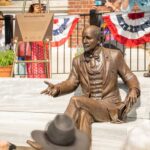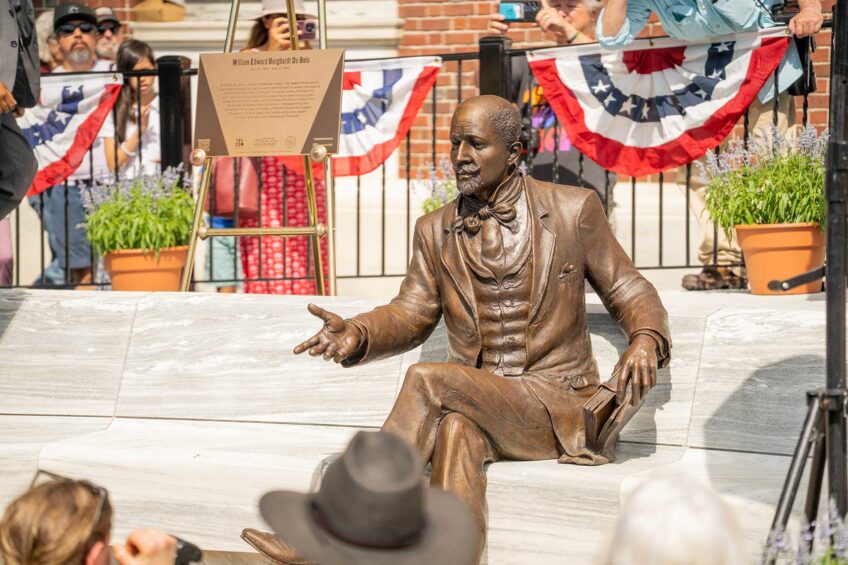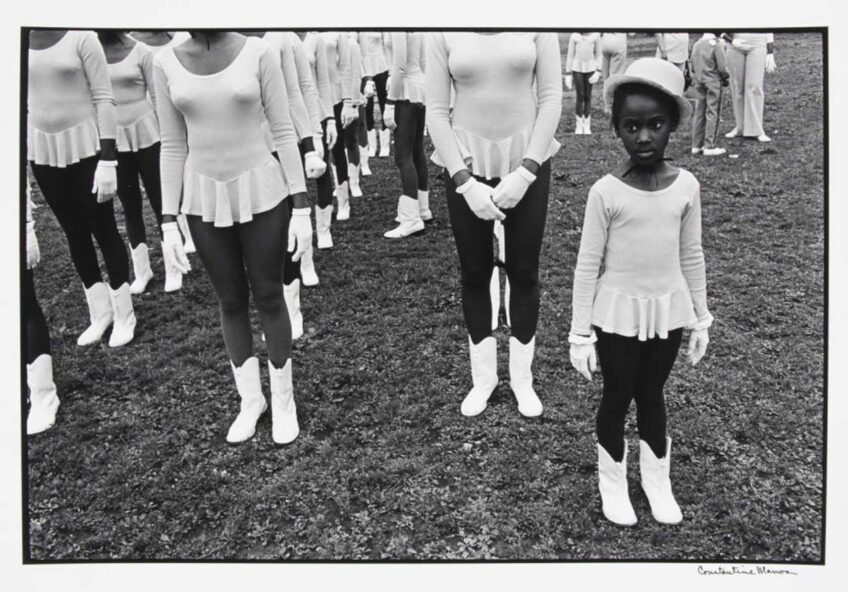
Banner Arts & Culture Sponsored by Cruz Companies
What once stood as an unused, grassy patch in the Charlestown Navy Yard now holds artworks honoring the past.
As visitors enter the yard, they are greeted by two sculptures: a quilted cocoon suspended in the air by three converging blue beams, and a vermillion Japanese Torii gate composed of two columns and two horizontal bars. At first glance, the pieces may seem disjoined from their locale, but they contain the memory of hidden histories of Charlestown.
The sculptures are part of Lot Lab, a free outdoor public art installation that transforms underutilized spaces into experimental, site-specific fixtures. The initiative began as a collaboration between the National Park Service and Boston Public Art Triennial, formerly Now + There.
The goal of Lot Lab is to “make an unused space a vibrant destination” where everyone is welcome,” said Jasper A. Sanchez, assistant curator of Boston Public Art Triennial. “We envision people coming to play, picnic, read, do [their] activities.”

“The Resurrection of Mark, Phillis, and Phebe,” a cocoon sculpture by artist Ifé Franklin, serves as a resting place for three Africans enslaved by a Charlestown man. PHOTO: DOMINIC CHAVEZ FOR THE BOSTON PUBLIC ART TRIENNIAL
Last year’s inaugural Lot Lab installation was a commissioned mural that enlivened an abandoned parking lot in Charlestown. This year, Lot Lab invited two artists, Matthew Akira Okazaki and Ifé Franklin, to create works for the chosen site under the theme of “presence,” which was inspired by the ongoing movement for uplifting untold histories in public space. Also part of the installation, which will be up until the end of October, is a previously commissioned work by artist Hugh Hayden.
“I was really thinking about how the language we use to explore those untold narratives and stories in public space can shift … our relationship to these stories,” Sanchez said, adding that he and his colleagues consider the theme of presence “as the power of community and being together.”
When he selected the artists, Sanchez didn’t know what they would uncover in their research. Franklin and Okazaki discovered connections to personal and broader, lesser-known histories in Charlestown — for Okazaki, histories of Japanese Americans, and for Franklin, African Americans.
During his tour of the Lot Lab site, Okazaki, an architect and professor at Tufts University, spotted a Torii gate at the Marine Barracks. The gate, he said, has the iconography of a Torii gate but is symbolic of something else entirely, having been adopted by the U.S. Marine Corps as a representative of the post-World War II era.
Okazaki, whose previous work stems from the Japanese American incarceration experience during World War II, was drawn to the idea of responding to the Torii gate in a sculpture of his own.
“My Torii gate was intended to quote a Torii gate, or what maybe a stereotype of a Torii gate might look like [and] actually perform more like a Torii gate, which is a marker of place, a passageway where people can walk through and meditate,” he said.
Unlike the nearby Torii gate, which Okazaki said functions “fine” as a “monumental marker,” his project is closely tied to the traditional purpose of the Torii gate as a corridor from the secular to the sacred, from the real world to the spiritual world.
His piece “TORII” was made from concrete, rebar, reclaimed wood and found rope, all materials meant to weather over time and develop a patina. The gate’s vermillion exterior is a callback to the color’s association with royalty and religion in Japan.
The stories brought to life in “TORII” haven’t been completely forgotten, Okazaki said, but now there’s a greater capacity to tell them.
Franklin’s piece, the floating cocoon made from indigo-dyed fabrics, also has strong ties to the past. Franklin was inspired by a conversation she had with Sanchez in which he told the story of about Mark, Phillis and Phebe, three enslaved people who rebelled against their enslaver, a Charlestown man, and were convicted of killing him.
“And once he told me the story … my mind started churning, and my heart just opened up, and I said, ‘Of course, I want to work on this. I’m not sure what’s going to come out of it yet, but I want to honor these ancestors,’” Franklin said.
She toyed with different ideas of how to present the artwork. Its final form came to her through the ancestors, she said, who told her it had to be a cocoon. The sculpture, titled “The Resurrection of Mark, Phillis, and Phebe,” represents a place for their spirits to come.
“They’re trapped in the trauma,” she said. “I want to bring a resting place for them, a place of sovereignty, a place of love.” She added, “And if they want to transform into the beautiful butterflies that they are, they can do that and fly off and be in a place of freedom.”
Franklin said she wants people to come away educated and encouraged after sitting with the sculpture and basking in its beauty. For those “who have been affected and are still affected by colonization,” she wants them to understand “that our ancestors are everything” and need to be uplifted.






